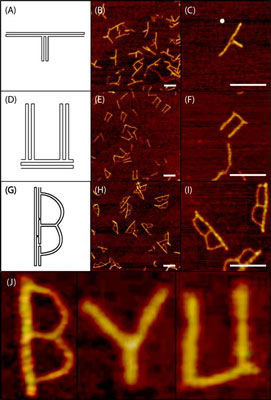| Posted: September 16, 2009 |
Spelling B-Y-U with DNA |
|
(Nanowerk News) College football fans cheer when marching bands spell out the home team’s name in gigantic letters on the field at halftime. Now scientists in Utah are reporting the ultimate in one-upmanship: Development of a new technology for writing the school name in letters so small that 500 would fit across the diameter of a human hair (or hundreds of thousands would fit inside the diameter of a human hair).
|
|
A report on the study, which helps overcome a long-standing challenge in nanotechnology, is scheduled for the October issue of ACS’ Nano Letters ("Polymerase Chain Reaction Based Scaffold Preparation for the Production of Thin, Branched DNA Origami Nanostructures of Arbitrary Sizes").
|
 |
| In an advance toward developing nanoelectronic devices, scientists in Utah arranged segments of DNA into tiny letters that spell BYU.
|
|
In this report, Adam Woolley and co-authors Elisabeth Pound, Jeff Ashton and Hector Becerril have devised ways to fold DNA into nanoscale structures that have multiple branching points. They also describe procedures to form nanostructures of various different sizes using the method of “DNA origami.” This work has potential application in forming nanoelectronic devices.
|
| In lab studies using the technique, and as a step toward Richard Feynman’s vision of information storage in “Plenty of Room at the Bottom,” they arranged segments of DNA into tiny letters that spell “BYU” — much like a marching band might form the initials for Brigham Young University. The letters are so small that hundreds of thousands would fit inside the period at the end of this sentence. The researcher note that these “small, thin structures with square junctions have potential applications in nanoelectronics, addressing the need for narrow, branched features for wiring.”
|

